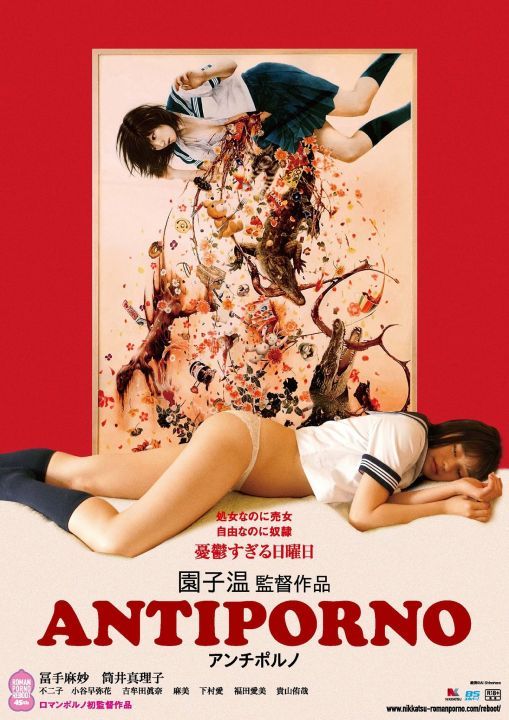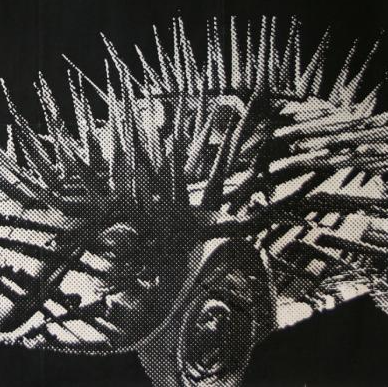Antiporno
SEX! Now that I've got your attention, etc., etc.

Japanese poster | Nikkatsu
2016 — Japan
A DJANGO FILM production, presented by NIKKATSU in association with SKY PERFECT JSAT CORPORATION
Cast: AMI TOMITE and MARIKO TSUTSUI, with FUJIKO, SAYAKA KOTANI, MANA YOSHIMUTA, AMI, AI SHIMOMURA, AMI FUKUDA and YUYA TAKAYAMA
Director and Writer: SION SONO
Producers: NAOKO KOMURO and MASAHIKO TAKAHASHI
Executive Producer: TADASHI TANAKA
Associate Producers: KIYOE TAKAGI and AKIRA YAMAMOTO
Editor: JUNICHI ITO
Cinematography: MAKI ITO
Production design: TAKASHI MATSUZUKA
Costumes: KAZUHIRO SAWATAISHI
Music: SUSUMU AKIZUKI
© Nikkatsu
The trailer is, would you believe, not entirely safe for work. Despite the age restriction slapped on it, it's not THAT dubious though (certainly I've seen worse that aren't flagged); there's like a bare bum and a painting that has exposed breasts in the background of some shots.
Fun fact: Japanese has a term, ‘onadoru’; a portmanteau of ‘onanism’ (onani; from German ‘Onanie’) and ‘idol’ (aidoru). It refers to a person who’s fantasised about during masturbation.
…Wait, that fact’s not fun at all!
I wrote a little while ago about the problems that Japanese cinema (and really a lot of others) was facing in the ‘70s. While I didn’t mention it at the time, probably the more common approach to the issue of competition from foreign exports was to sex it all up good like! In the mid ‘60s, there was a loosening in restrictions of depictions of sexual content on film in Japan. Well, sort of. There was an obscenity trial and stuff. It was unsuccessful and essentially seemed to make it open season to make racier films. Bear in mind that there’s a difference between just portraying sex on film and actually showing sex; there was a fairly strict if somewhat unspoken code as to what was now acceptable, which entailed things like not showing genitalia (or even pubic hair)† and generally avoiding showing much if any detail of the (simulated) act. This had a particular effect outside of the studio system, with smaller companies popping up to make these so-called ‘Pink films’ (supposedly the ‘pink’ moniker refers to the abundant show of skin, though I’ve seen other suggestions too). By the ‘70s, the bigger studios began to take notice of the popularity of such films and decided to make sexploitation films of their own albeit with the greater resources at their disposal. Most infamously Nikkatsu and Toei went to that well, though others also dabbled in it. While Toei’s ‘Pinky Violence’ line of films, as the name suggests, had a yen for sexed up grindhouse action affair, Nikkatsu’s line, dubbed ‘Roman Porno’,‡ took a rather different tack. Essentially Nikkatsu gave directors more-or-less free rein artistically so long as the resulting film was delivered on budget and on schedule and hit the requisite quota of sex and nude scenes. As such, this not only saved the company (well, at least until the rise of video, when you could get actual pornography in your home and predictably the softcore stylings available at the big chain cinemas lost their appeal for a sizeable chunk of the audience) but also oddly enough gave them a creative and critical boom period. (A lot of the output does seem to be pretty much what you might expect though.)
This is largely just background info that I’ve gotten second-hand. I’m not familiar enough with Pink film to really talk with any authority on the subject, having, as I write this, seen a grand total of none of them, or any of Toei’s efforts either, though I have seen one Roman Porno film; the luridly titled Trapped in Lust (1973), which is included as an extra on the Blu-ray release of Branded to Kill (1967) with which it shares writers and also flagrantly recycles the premise.
Anyway, the Roman Porno era was a rather important time for Nikkatsu, Japan’s professed oldest film company which is true assuming you put some provisos on that statement, and they trotted out a bunch of re-releases of some key ones for the company’s centenary. These apparently proved popular, especially with women to their surprise, and so set about creating a new sequence of films in the vein of the original Roman Porno series but with a more female focus, and so 2016 saw the Roman Porno Reboot Project, five films from some big name directors in modern Japanese cinema, including Hideo Nakata (Ring) and Isao Yukisada (Crying Out Love in the Centre of the World), ostensibly made in the same sort of conditions as the originals (low budget, one week’s shooting, about 70-80 minute run time, that kind of stuff; though there was apparently an edict to avoid certain more distasteful tropes of the original range, as well as producing some less explicit alternative shots in order to make TV broadcast versions). That said, despite the supposed female focus, all the films are by directed men and only one seemingly (co-)written by a woman (Yukisada’s Aroused by Gymnopedies). Antiporno here is the fourth of the quintet, directed and written by Sion Sono, who, in an interview about the film, about the first things out of his mouth were that he’s not really interested in the ‘Roman’ and isn’t keen on the ‘Porno’. So that’s off to a good start. What ensues is a film that’s angrier than presumably anyone expected going in.
Kyoko (Ami Tokite) is a phenomenally successful lady novelist, artist, fashionista, bonne vivante, you name it, except for the ‘lady’ part. While she may not be a lady, yadda yadda yadda, her actual objection is that using gender as an adjective to professions because that is ghettoising. However, she’s insecure in her position, having achieved this apparent stardom in record time. She lives alone in her garishly coloured studio with no one but her sister’s ghost (Ami Fukuda) to talk to and, during the daytime, her prissy PA Noriko (Mariko Tsutsui) to abuse. Today, they’re expecting an interview and photo shoot for a prestigious fashion magazine, with the editor-in-chief (Sayaka Kotani) no less. This provides ample opportunity to both humiliate the frumpy Noriko in front of the beau monde and to expound on her personal philosophy on how to be truly free as a woman in Japan. …Or not; partway through, when sex is imminent, she runs off to barf, prompting the end of the take. It’s naught but a film set, and everyone’s very displeased with her; none more so than veteran porn star Noriko, who sees the newcomer Kyoko as astoundingly unprofessional and a total amateur. Kyoko’s world, life, identity and reality are all unravelling, and she’s increasingly uncertain as to who she is and who she wants to be.
Jaime Grijalba posits that the (perhaps unintentional) running thread through the films of the Roman Porno Reboot Project is that of fame, with a whole load of stuff about the intersection between celebrity and sex (and sometimes art), with one feeding into the other in an often cyclical fashion. In the case of this film, Kyoko believes her autonomy rests on sexuality; the Madonna/whore dichotomy writ large. A successful independent woman is, in her mind, inherently a slutty one, and so that is the state she must achieve if she is to escape from the hypocrisy that ensconces her. This is, of course, nonsense; her release from her mundane ordinary reality has little to do with her attempts at promiscuity. This much is readily apparent and the plot hinges somewhat on her voyage of self-discovery taking that in. While the different layers of reality bleed into one another, the throughline is her mistaken assumption that sex will afford her the means of attaining success and thus freedom; but the big question is as to what is ‘freedom’ in modern society.
A major element of this is in Ami Tokite’s casting. Tokite was, as many sources about the film note, a member of idol group AKB48, one of Japan’s big academy-style pop idol projects (though there does seem some level of an exaggeration; she was apparently a part of the larger ensemble for about six months, and never made it into one of the main bands). The relationship between the idol industry and the pornography industry, soft or otherwise, is quite entrenched to a downright unpleasant level to a degree that pretty much any Japanese media that isn’t actively celebrating idol culture will generally touch on it; celebrity, for women, at least, tends to rely on a sort of virgin-whore image which is carefully cultivated and micromanaged by their handlers. Idols can be sexualised to hell and back, but they must also be completely pure and chaste, body and soul, and any behaviour to suggest that they might not be must be punished. All that said, it has been known for unscrupulous agencies to lure the unaware into the porn industry; the sort of sexualisation a person starting out on a ‘mainstream’ media career in Japan faces isn’t all that far removed after all.
Noriko (the actress) objects to Kyoko’s (the actress) apparent portrayal of Kyoko (the character) as being largely free from care and generally living her best life, yet her own interpretation of the character is based wholly on the idea that forthright female sexuality is to be feared and reviled; a monstrous creation of male Frankensteins. This is reflected even in the colour palette, the brightly lit yellow of Kyoko’s world giving way to moodier shaded oranges, as Noriko snarls her way through a reprise of the film’s first act. The attitudes towards female sexuality in the film that assail Kyoko are uniformly unhealthy, with her parents instilling the idea of it being shameful (while going at it any chance they get) and those working on the film running with the idea that there are few things more terrifying. The freedom that sexual liberation is apparently willing to afford women in modern society is still on male terms, and thus should not be accepted as is.
To this end, perhaps the most obvious point of comparison would be something like Daisies (1966), Věra Chytilová’s controversial surreal comedy about a pair of young women who decide to be ‘bad’ and stop playing by society’s rules. Both of the films even reach their climax with an orgy of mess and destruction (not a literal one) and a repudiation of their respective societies. At the same time, Antiporno functions as a tale of sexual awakening; the multiple Kyokos, the confusion between them being the questioning of her identity, who she is, who she wants to be. The rules of society to which she doesn’t wish to conform are expressly sexual in nature, after all, however there’s a grander concern to her worries about women’s freedoms than simply being a Madonna or a whore, as hinted by her irritation at being referred to as a ‘lady’ novelist.
† While the pubic hair thing has since been repealed, Japanese censorship laws still prohibit the portrayal of genitals outright. This is in fact true even of hardcore pornography. This has suggested as a reason for some of the more… eclectic erotic content in Japanese media, such as the infamous tentacle variety. It’s a way to dance around actually showing the action as it’s commonly understood and therefore within the letter of the law.
‡ Quite what the name ‘Roman Porno’ is meant to mean, or at least what the ‘Roman’ part refers to, is one of those open to debate things. The standard things tend to be either that it’s a contraction of ‘romantic’ or that it’s as in the French (and various other European languages) for ‘novel’, as in roman pornographique. The specifics of that probably rather moot overall, as I think we can all agree that in reality it was a marketing decision to make it sound somehow more respectable than it necessarily was.
At time of writing, Antiporno is available to rent off of Amazon and Apple TV, amongst other services, and is streaming on Mubi (including on Amazon if you're subscribed to the Mubi service) . I recommend JustWatch for keeping up with where films are streaming (including this one!). Alternatively, physical copies are reportedly available for rent via Cinema Paradiso.
The film presently has a 18 rating (last being submitted in 2018), with the BBFC citing "very strong language, strong sex references, [and] sex". As they include in their detailed notes, the strong language includes a discriminatory term.
Sources
Anahori, T., 2016. 'Japanese 1970s erotic cinema returns: Roman Porno films make comeback', Tokyo Kinky. [online] Available at: <https://www.tokyokinky.com/japanese-erotic-cinema-roman-porno-films-reboot/> [Accessed 13 May 2021]. PLEASE BE AWARE THAT THIS WEBSITE IS NOT SAFE FOR WORK.
Balman, C., 2017. 'Roman Porno: Screening Male Desire?', Screening Sex. [online]. Available at: <https://screeningsex.com/2017/06/06/roman-porno-screening-male-desire/> [Accessed 1 April 2021].
Genkinahito, 2017. The First Wave and the Reboot of Nikkatsu's Roman Porno Films at Nippon Connection Film Festival 2017. [online] Available at: <https://genkinahito.wordpress.com/2017/05/13/the-first-wave-and-the-reboot-of-nikkatsus-roman-porno-films-at-nippon-connection-film-festival-2017/> [Accessed 15 May 2021].
Grijalba, J., 2019. 'Fuck Me, I'm Famous: A Nikkatsu Roman Porno Reboot Review', Film & Fishnets (Vol.4). [online]. Available at: <http://filmandfishnet.com/fmeimfamous> [Accessed 1 April 2021].
Hood, N., 2017. 'The Antierotica of "Antiporno"', Notebook. [online]. Available at: <https://mubi.com/notebook/posts/the-antierotica-of-antiporno> [Accessed 15 May 2021].
Mealey, R., 2017. 'Women in Japan tricked into pornography under guise of modelling contracts and fame', ABC News. [online]. Available at: <https://www.abc.net.au/news/2017-06-10/increasing-number-of-japanese-women-forced-into-pornography/8602288> [Accessed 17 May 2021].
Nikkatsu, [unknown]. What is "Roman Porno"?. [online]. Available at <https://www.nikkatsu.com/en/images/What%20is%20Roman%20Porno.pdf> [Accessed 1 April 2021].
Nornes, A.M., ed., 2014. The Pink Book: The Japanese eroduction and its contexts. [pdf] Kinema Club. Available at: <https://kinemaclub.org/pink-book-japanese-eroduction-and-its-contexts> [Accessed 30 April 2021].
Smith, J., 2016. 'The softcore feminist romp ushering in the new Roman Porno New Wave', Little White Lies. [online]. Available at: <https://lwlies.com/articles/sion-sono-anti-porno-roman-porno-new-wave/> [Accessed 17 May 2021].



